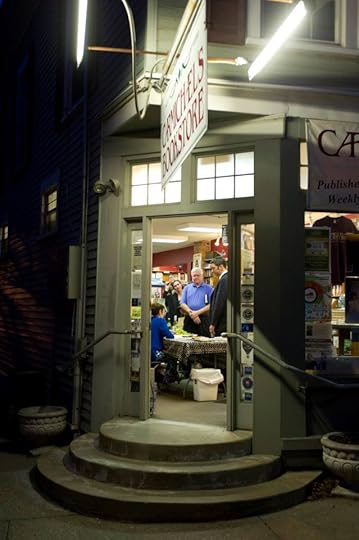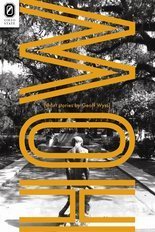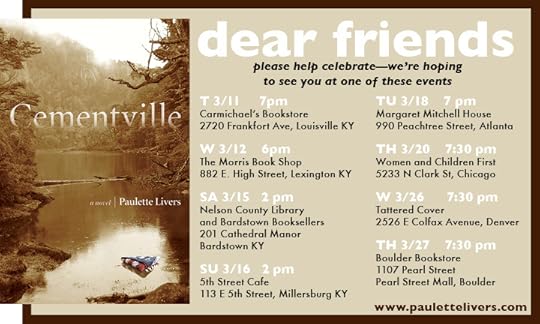Paulette Livers's Blog: Paulette Livers at GoodReads, page 3
June 23, 2014
“About a Character” Blog Hop
Thanks so much to Thaisa Frank for inviting me to join this blog hop. When she first told me that we would answer questions about a character in our writing, I wasn’t sure how I would choose, because my new novel has multiple characters, most of whom I love, whose voices tell the story of their small Southern town’s experience of the Vietnam War.
What is the name of your character? Is s/he fictional or a historic person?
My fictional character is Wanda Ferguson Slidell, a 30-year-old agoraphobic living on a small farm with her ailing mother.
When and where is the story set?
My novel CEMENTVILLE takes place during the summer of 1969 in the rural South during the height of the Vietnam War.
What should we know about her?
Wanda is something of a social mutt. Her mother Loretta is from the disreputable Ferguson clan, and although Loretta’s father worked hard his whole life to overcome the family’s reputation for drunken violence and laziness, the stain clings. Wanda’s dead father, Stanley Slidell, was the only son of the town’s wealthy grand dame, Evelyn Slidell. Stanley was a romantic alcoholic who died ignominiously in the back of a car where he had passed out. As the novel opens, Wanda’s hilltop social isolation with her taciturn mother and some farm animals has become convenient habit, allowing her to avoid the real world and the grief enveloping the town below as the war dead come home.
What is the main conflict? What messes up her life?
Wanda has been oblivious to the fact of being Evelyn Slidell’s only heir; after all, Evelyn has never pursued a relationship with her only grandchild, blaming Loretta and Wanda for her son Stanley’s ruin. When the two finally come together, Wanda sees something of herself in her reclusive and bitter grandmother, while also worrying that her pending sudden wealth may topple the carefully preserved bell jar of her life on the farm.
What is the personal goal of the character?
At the beginning of the book, Wanda’s goal is defending her own status quo. The bodies of eight local young men are coming home from Vietnam and Wanda’s main worry is that her mother will make her attend some of the funerals. Subsistence at every level—emotional, physical, mental, and economic—has been narrowly tied to the hilltop farm from which she observes the town below. As the book progresses, events pry open Wanda’s expectations of herself and her relationship to others.
What is the title of this novel, and where can we read more about it?
CEMENTVILLE can be found wherever books are sold. More about the novel and about my writing can be found at www.PauletteLivers.com. You can also follow me on Facebook https://www.facebook.com/PauletteLivers.Writer?ref=hl&ref_type=bookmark and on Twitter https://twitter.com/PLiversWriter
When was the book published?
CEMENTVILLE came out in Spring 2014 from Counterpoint Press.
Again, much thanks to Thaisa for inviting me to join in. Next week, Please come back to my website to hear what two good writers have to say about characters they have created. Neither of these two has a blog themselves, so they will guest blog here at PauletteLivers.com/journal.
Don De Grazia is author of AMERICAN SKIN, a unique bildungsroman about one young man’s experiences when he joins a group of anti-Nazi skinheads in Chicago. Don teaches in the fiction program at Columbia College.
Geoff Wyss is the author of HOW. The protagonists in this New Orleans-set story collection are the kinds of characters who stay in your head long after you’ve closed the book.
I can’t wait to hear what Geoff and Don have to say about these people.
May 21, 2014
Review: Cara Hoffman’s “So Much Pretty”
 Full disclosure: I was led to Cara Hoffman‘s work by the upcoming 2014 Printers Row Lit Fest. Chicago Tribune journalist Steve Mills will be directing a conversation with Hoffman and myself on June 7 during Chicago’s annual celebration of literature.
Full disclosure: I was led to Cara Hoffman‘s work by the upcoming 2014 Printers Row Lit Fest. Chicago Tribune journalist Steve Mills will be directing a conversation with Hoffman and myself on June 7 during Chicago’s annual celebration of literature.
The fiction Hoffman and I write shares much: The rural setting caught in a violent spin, themes of vengeance, denial, the wages of war, and of environmental destruction. Gone are the days of reading for pleasure, if I ever read that way (okay, The Mists of Avalon, while I was lying on a sugar sand beach, that was pleasure). I read “So Much Pretty” the way I do most novels, with the eye and mind of a writer.
Some readers will quibble with the rapid-fire switches in point of view, encompassing the voices of many townspeople: a reporter who wears all the hats at the tiny local paper, the police chief, parents, high schoolers, interviews and police blotters.
 But it was this piecing out of information, the challenge of following the accumulation of understanding about what was happening to the town, that kept me reading. Hoffman manages in less than 300 pages to paint portraits of her characters’ desires and secrets and fears, assembling a study of a unique family of outsiders and the isolated town they’ve chosen to call home. That she simultaneously weaves a murder mystery, a despotic agribusiness, and law enforcement that fails resoundingly to speak truth to power (all in vivid prose that never devolves into mechanics) makes this an impressive debut.
But it was this piecing out of information, the challenge of following the accumulation of understanding about what was happening to the town, that kept me reading. Hoffman manages in less than 300 pages to paint portraits of her characters’ desires and secrets and fears, assembling a study of a unique family of outsiders and the isolated town they’ve chosen to call home. That she simultaneously weaves a murder mystery, a despotic agribusiness, and law enforcement that fails resoundingly to speak truth to power (all in vivid prose that never devolves into mechanics) makes this an impressive debut.
During the final pages, I found myself squirming with that restlessness only the best sorts of stories can bring out, in which what is moral or legal or responsible shifts from black or white to multiple shades of gray.
Next up: Cara Hoffman’s just-released novel, Be Safe I Love You
April 28, 2014
Book Giveaway on GoodReads!

Reading Child fountain at Cave Hill, Louisville KY
If you haven’t already joined GoodReads, now is a good time to do it, because through the month of May you can enter a free drawing for 5 chances to win a copy of CEMENTVILLE. GoodReads is the largest site for readers and book recommendations in the world, and opening your free account couldn’t be easier. And while you’re there, please enter to win a copy of CEMENTVILLE. I will be giving away 5 copies from May 1 through June 1.
If by chance you’ve already read my new novel, please do proceed with your (hopefully) glowing review.
April 21, 2014
Chicago writer Patricia Grace King answers questions about her writing process
A few weeks ago I tagged Patricia Grace King to participate in a blog relay about our practices as writers. This “blog tour” was started by Erin Albert last October and has gone on more or less uninterrupted since. Each tagged writer answers 4 questions, posts them on her or his blog, and tags 3 more writers. As Patricia hasn’t yet added a blog page to her lovely website, she has graciously allowed me to post her answers.
Please take note, though: Patricia will be beginning her new blog in the next few weeks, and it promises to be worth following. Please visit her at www.PatriciaGraceKing.com
Here is what she has to say about her writing process:
1. What am I working on?
Well, I have been working on a collection of stories, set in wartime Guatemala, called Gringos in Paradise. I thought I would finish it by this summer for sure! However, for obvious reasons, I’ve not worked on it at all for the past month. And it seems I may now be starting a blog which I’m tentatively calling Greetings from Cancerland. (I hope to have it up and running by the end of April!) I imagine the next year will be a mix of working on both.
2. How does my work differ from others of its genre?
So, I write literary fiction—fiction that is character-based and that pays attention to language. (How I love beautiful language!) I’m a narrative realism kind of gal, too, if that means anything to you. I aspire to write stories and novels on the level of Ben Fountain’s Brief Conversations with Che Guevara, Ann Patchett’s Bel Canto, Norman Rush’s Whites and Mating.
Not coincidentally, those works are all set in other countries, specifically in the developing world, and to some extent deal with North Americans trying to make their way or make sense of their new settings. That’s what my stories (and eventual first novel!) do, too. But mine may differ a bit in that my setting is Guatemala. I sometimes think that my political and moral world view, which comes of having spent a lot of time among leftist Mennonites (!), distinguishes my work too.
3. Why do I write what I do?
With Gringos in Paradise (and my planned first novel—Rooster Hour), I write because I’m haunted by Guatemala, a country where I’ve lived on and off for much of my adult life, and where I’ve had some of my most formative moral experiences. With the forthcoming Greetings from Cancerland blog, I’ll be writing partly to keep my community posted on this weird and unexpected journey through breast cancer and partly, I’m sure, for my own catharsis.
4. How does my writing process work?
While this past month has been the exception, I need to write at least a little bit every day. (Well, okay, not on teaching days: teaching takes my creative energy for the day.) Writing regularly keeps the mental wheels greased! I begin my writing process each day by reading for an hour or two: either for research or, even more importantly, for inspiration. I try to read (and re-read) literary works that make me want to write equally well and that teach me to be more skilled and thoughtful in my craft.
Then, y’all, I . . . um, write. Who knows how to describe this rather mystical process? I sit at my desk and move words around until some spark ignites. Sometimes it won’t ignite until I’ve sat here for several hours. And then suddenly I’m typing like a demented person, making all kinds of type-os but basically just trying to transcribe what seems to be coming down to me through the ether! Then I go back and clean it up, tighten the crap out of it.
But the trick is to stay with it, to keep your mind and your soul on the page.
April 7, 2014
“My Writing Process” blog tour
Thank you, Christine Sneed at www.christinesneed.com for involving me in this blog tour. Her Paley Prize-winning story collection Portraits of a Few of the People I’ve Made Cry and novel Little Known Facts are some of my favorite reads from the last couple of years. This 4-question relay was started by last October by Erin Albert. The way it works is: A writer invites you to answer four questions. You carry the relay forward by inviting three more writers to do the same. One person described it as “not quite a chain letter. You don’t end up with good fortune or 1,000 picture postcards from around the world or bad luck if you break the chain.” Still, I will take all the luck I can get. So here goes with my answers to the questions about work process.

At Carmichaels in Louisville KY, March 11, 2014. Photo by Robert Dorzback.
1) What are you working on now? I’m in the throes of publicity land with my debut novel, Cementville (Counterpoint, 2014), just back from a March-long book tour. Fortunately, before my pub date, I was already knee-deep in the next project, another novel. I usually have several things going at the same time, which I am not recommending. In fact I am recommending to myself right now that I stop that at once before my head explodes.
2) How does your work differ from others of its genre? My least favorite of these questions. Because however this one is answered, there’s a chance you’ll come off sounding like trying to be different is the main thing, and it really isn’t, at least for me. Whether readers subscribe to the idea that there are two basic stories, that somebody takes a trip or a stranger comes to town, I hope readers will read my work because the story and characters pull them. I will say that the two protagonists in this new text I’m working on are neither young, beautiful, hip, nor rich. Nor are they men. My agent will probably cringe as she reads this.
3) Why do you write what you do? I write fiction because it’s the one place my control-freak nature is actually an asset. My rules, in a world I make, populated by people I want to watch get into trouble.

The changing Mississippi River bed. Harold N. Fisk’s colorful drawings of rainbow ribbons reconstruct the river’s twisting path over time. I ran across these maps on Flavorwire.
4) How does your writing process work? This will sound strange after the comment above about being a control freak. But I seem to start new texts with fragments that are almost random and can feel homeless. Does this slightly freak out my inner control freak? Why yes it does, because I have to turn off critical judgment and just put down word after word, and allow space between the fragments, and wait and watch and listen. The fragments begin glomming together into something like relationships, usually between people who may have no business relating to one another. The feeling of getting that first draft is best described by referring to the lovely and somewhat horrifying drawing to the left. Only after I have the first draft do I outline, so that as I begin shifting and compressing and expanding I don’t lose track of the through lines. I do lose track of how many revisions the darn thing will go through after that first draft though. And a good thing that is, because once my agent looks at it, there’s a good chance it will go through more revision. And we aren’t even talking about what happens when my editor gets hold of it. This is when my control-freak nature has to take a back seat and I get to let my head open up even further to ways to make the manuscript the best it can be.
Thanks for stopping by and reading. Be sure to check out the writing process of a few of my favorite writers one week from today, April 14, when they post answers to these questions on their blogs.
CLIFFORD GARSTANG’S novel in stories, What the Zhang Boys Know, won the 2013 Library of Virginia Literary Award for Fiction. His first book, In an Uncharted Country, a collection of linked short stories, won the Maria Thomas Prize for fiction. His work has appeared in Bellevue Literary Review, Blackbird, Virginia Quarterly Review, Cream City Review, The Tampa Review, and elsewhere. In addition to an MA in English and a law degree, he holds an MFA in Creative Writing. He is the co-founder and editor of Prime Number Magazine and is also the editor of Everywhere Stories, a short fiction anthology that will be published later this year. Read about Cliff’s process on April 14 at: http://cliffordgarstang.com
EMILY GRAY TEDROWE is the author of Commuters: a novel (Harper Perennial) which was named a Best New Paperback by Entertainment Weekly. Her short fiction has been published in the Chicago Tribune’s Printers Row Journal, Fifty-Two Stories, and Other Voices. Her new novel, Blue Stars, was conceived during her brother’s Marine service in the Iraq war, and is forthcoming from St. Martin’s Press. Originally from New York City, Emily now lives in Chicago with her husband and daughters. Read about Emily’s writing process on April 14 at her site: www.egtedrowe.tumblr.com
PATRICIA GRACE KING grew up in North Carolina and spent years in Spain and Guatemala. She holds an MFA from Warren Wilson College and a Ph.D. in English from Emory University. Her stories appear or are forthcoming in Ploughshares, Narrative Magazine, Nimrod, and other journals. Her chapbooks, The Death of Carrie Bradshaw and Rubia, won the Kore Press Short Fiction and the Jeanne Leiby Memorial contests, respectively. She is the recipient of a Pushcart Prize nomination and a fiction fellowship from the Vermont Studio Center. She is the 2013-2014 Carol Houck Smith Fellow at the Wisconsin Institute for Creative Writing and lives in the Printers Row neighborhood of Chicago with her husband. On April 14 Patricia will answer the questions at her site: www.patriciagraceking.com
April 2, 2014
Yesterday was my birthday. All day long. Home in bed with...
Yesterday was my birthday. All day long. Home in bed with a killer head cold, I tried to write this yesterday, but with each sentence I put down, there were three sentences I knew I was leaving out. For all my commitment to radical honesty, for all the wisdom my years are alleged to have conferred upon me, staring me in the face was the ugly fact of a certain counterfeit confidence that seems to have infected the agora of the communication age. I wanted quotable phrases of searing probity. I wanted to smile for some invisible camera and be as beautiful as Susan Sarandon on the cover of AARP. I wanted desperately to be as heartened as Oliver Sacks sounds in his essay, “The Joy of Turning 80,” the reading of which jump-started my birthday morning. I’ve followed his work since discovering some years back his collection of “clinical tales” entitled The Man Who Mistook His Wife for a Hat, about neurological aberrations that cause us humans no end of crazy experiences. Several things Sacks divulges in his essay on aging touched me.
 During a mountaineering accident at the age of 41, Sacks thought he was a goner. He splinted his broken leg and levered himself down the mountain, and all he remembers about those hours was feeling thankful for his life. A drunken car accident at 18 nearly did me in, but unlike Sacks, it would be some years before I understood that survival was something worthy of my gratitude.
During a mountaineering accident at the age of 41, Sacks thought he was a goner. He splinted his broken leg and levered himself down the mountain, and all he remembers about those hours was feeling thankful for his life. A drunken car accident at 18 nearly did me in, but unlike Sacks, it would be some years before I understood that survival was something worthy of my gratitude.
He admits to being sorry for a few things too, of course. That he is as shy now as he was at 20. That he still only speaks one language, and hasn’t traveled as widely as he should have. Like me, he regrets his flair for wasting time. Well, not really like me. If I write (and publish) 10 more books in the next 20 years, I will catch up with him. Unless, that is, he continues his prodigious output during his next 20 years.
Which reminds me of something that I wasn’t thinking about yesterday at all: I just returned from touring old haunts around the country, reading from my debut novel. Yesterday, as frustration caused my sentences to lurch and splutter in their search for poignancy, I forgot that, three weeks before my sixtieth birthday, my first book was published. Yesterday I wasn’t thinking about the crowds of friends, family members, and readers I’d never met who came out to help me celebrate Cementville. Completely gone from mind were the good reviews and kind words of writers and mentors I admire.
Since my last big decade birthday I have squandered inordinate amounts of time wondering where I fall in age compared to almost anyone around me. In social circles, during meetings, even at literary readings that I’ve looked forward to for weeks, my mind is helplessly calculating whether the person at the podium was even born when I was a dreaming adolescent, and to which of those present I am old enough to have given birth. When I am in the depths of my age anxiety (what some of my more heartless friends ungenerously refer to as ‘sitting on the pity pot’), there rises up an ocean of contests for thirty writers under 30 or new awards for the under 40s. I’m sure writing and the arts in general are not the only professions made up mostly of the foolhardy young. Those of us who stick it out beyond our forties are generally either nestled in the reasonable comfort of a decent teaching job; or happen to be tough birds who (sometimes, not always) can call up other resources when burdens become too much to carry alone; or we were just not all that tightly hinged to begin with.
The thing is, I honestly don’t envy the young writer. Over lunch with a youngish writer friend recently I commented how glad I was that the first novel manuscript I wrote didn’t end up being my first book. Why? He wanted to know. I’m a better writer now, I said, because I’ve written a lot more, and I’ve experienced more. A smile washed across his face and he said, You don’t know how good it is to hear you say that! My acknowledgment of good things coming with the passage of time gave him some relief from the pressure to be a prodigy. Because with age, self-doubt does seem to diminish and, most days, I can work in relative peace, the old naysayer goblins a bit quieter than when I was forty. I’m better at seeking out likeminded friends and have less time for the vampiric ones. Things on the inside actually feel as good or better than ever.
As for the looks of things on the outside: Yes, there are mornings I don’t look in the mirror when I comb my hair. But I don’t think my worries about aging have as much to do with vanity as with the fear that I haven’t done enough with the years I’ve already been allowed; even worse is that I might continue to squander what time lies before me. For Sacks, the looming specter is dementia or stroke, neither of which seem a big factor in my lineage. My forebears mostly died of some form of cancer before they were old enough to lose their marbles.
Here’s the thing: Yesterday I reached the age my mother was when she learned she had leukemia. I was 25 with a new baby when my mother died a year after her diagnosis. In the last few years I’ve lost three siblings to cancer, none of them over 62.
But here’s the other thing. I love my life, and not necessarily because I came so close to losing it when I was a stupid 18-year-old driving drunk on a narrow country road. I love my life for what it is right now, for waking up every day next to a man I adore, a man who would walk to the ends of the earth for me (which, in Italy this past spring, he nearly did). I get to work in a house we cobbled up the way we want it, in a neighborhood that always surprises me, in a city that teems with life, doing work that challenges me to put word after sweat-wrung word down on the page, along with the occasional opportunity to work with writers I respect. I’m a member of a family that continues to astonish me with its generosity, the kind you almost never hear about these days, who believes wholeheartedly in what I’m doing.
Falling short of Sarandon’s beauty or Sacks’ genius, I want to believe that this birthday marks a recommitment to surrendering my work life to the philosophy that has not failed me. As Anne Lamott phrased it, “bird by bird.” This day, this 24 hours. A day at a time.
March 21, 2014
Razor-sharp Poignance in Geoff Wyss’s “How”

Geoff Wyss. Photo by Samantha Scheel.
Last summer at the Sewanee Writers Conference, I picked up a copy of Geoff Wyss’s story collection, “How,” winner of the Ohio State University Prize in Short Fiction. I’ve savored one story a week over the past eleven weeks, and now find myself envying everyone who has the pleasure of reading this extraordinary collection for the first time. Wyss is a New Orleans school teacher, and some of the stories here are steeped in the atmosphere of the faculty lounge, faintly buzzing with gossip, the tense classroom relationships, haunted by the burnt-out teacher who wants to be left alone to do his work, or left alone period. Wyss’s dark comic sense is burnished to a mature gleam here, with characters that could only be so fully drawn by a writer who has spent some years studying human nature. He isn’t bothered a whit with the current popular argument over characters’ likability. Those populating the New Orleans of “How” are simultaneously droll and rude, tender and mean-spirited, charmed and charming, and you can’t take your eyes off them. Or your ears, I should say. Line for line, the prose crackles. Listen to this, from a story titled “Exit Strategy”:
“Every time she used a kitchen knife, she imagined cutting her finger off. You know how your brain gets stuck, looping its junk on cue? Freaking itself out, filling time as it falls apart? Except that lately she’d been seeing it so vividly that she’d started to think it wasn’t dementia, her mind misfiring, but a premonition: the knife slipping off a tomato and diving into the first knuckle of her finger, shushing through the bone, clean and for a moment painless, the exposed rings of her finger glowing like a lit cigarette. She had never cut herself in the kitchen. Didn’t that make it more likely every time?”
I mean, Ouch. You practically feel the citrus sting of tomato juice as it rinses over open flesh. Shannon, in whose point of view this story is told, is drawn to a guy who works out at her gym, while she is simultaneously horrified that she is attracted to him. Wyss’s sentences spool out in what I have to call physical lyricism, so closely following the irritation of the senses, his characters’ hairy legs and their junk-looping brains.
The protagonist of “Arms” doesn’t need to go into his own backstory when his perception of his girlfriend’s pals tells us so much about him: ”Tim wore Goth makeup and had a beer belly. Vicki was a wan, wordless girl who seemed deficient in protein and never looked up from the table. … They had been coming here since they were the age of the fake-ID kids crashing together on the dance floor. This is where they had huddled while time besieged them, and they looked a little disappointed by the discovery that they had somehow survived and were now twenty-three.”
The narrator of “Saints and Martyrs” pulls no punches when describing her moment of attainment with her childhood sweetheart: “There’s no way to hide the fact that neither of us is much to look at. Don is slim, but he’s maintained his slimness by slowly ceding his muscles, so that his visual effect is soft and milky, like boiled veal.” She is no easier on her own physicality: “I am, from the waist down, absolutely impervious to all diets and forms of exercise. It’s my huge ass that is, in some way, the source of all my humiliations and achievements, the way the Civil War is for the South.”

HOW. Available from Ohio State University Press.
But lest you think Wyss is without sympathy for his characters, think again. If you’re paying attention, you’ll hear the low-register hum of what Steve Almond calls “radical empathy.” If we haven’t experienced at least some of the disappointments of the ordinary, desperate folks who people “How,” or blundered as badly, then maybe we’ve been living too cautiously. It’s the stealth element here that will sock you in the gut. Because as soon as you’re done laughing—or wincing (and you will wince sometimes)—at one character’s raunchy line, Wyss delivers a tiny personal bomb, no less revelatory for being lit by roadside fireworks than if it had been itself a burning bush.
March 4, 2014
One week until publication of CEMENTVILLE
The day I have fantasized about is just a week away. With a head still energized by last week’s annual conference of AWP (Association of Writers and Writing Programs), it’s time to focus on Cementville‘s approaching launch parties. Best of all, the tour opens with a week-long journey across my home state.

Carmichael’s Bookstore, 2720 Frankfort Ave. Louisville, KY
Kentucky stop #1: Louisville. Carmichael’s Bookstore, 2720 Frankfort Avenue, Tuesday, March 11, 7pm. Louisville is where much of my sprawling family lives. The city has the largest collection of shotgun houses in the United States, thanks to German and Irish immigrants who set up shop here. The West Main District, listed in the National Register of Historic Places, is home to the largest collection of cast iron façades outside New York’s SoHo district. The district also features “Museum Row“, a collection of several notable museums located within just a few blocks of each other.

The Morris Book Shop, 882 E. High Street, Lexington
Kentucky stop #2: Lexington. The Morris Book Shop, 882 East High Street, Wednesday, March 12, 6pm. Lexington is home to the longest running literary conference specifically for women, the Kentucky Women Writers Conference in the historic Carnegie Center every fall. The city has grown since I traipsed across the campus of UK as a freshman. Thankfully, the hospitality hasn’t been lost with all the change. Last September, the hotel bellhop—against the wishes of his boss—personally drove me to the Lyric Theater and Cultural Arts Center, because I was worried I would be late for the “Off the Road Rally.” At the Lyric, I got to hear Wendell Berry and Barbara Kingsolver and other Kentucky authors whip up a sold-out crowd for the preservation of the Kentucky River Pallisades, Marble Creek, and a whole swath of Bluegrass Country threatened by a proposed Interstate road. You would have to have lived under a rock to not have heard of the legendary horse farms around here, but I may love even more the narrow shaded lanes bordered by dry stone walls, some of which are over 200 years old.

Justly proud of this designation. Nelson County Public Library, 201 Cathedral Manor, Bardstown.
Kentucky stop #3: Bardstown. Nelson County Public Library, 201 Cathedral Manor, Saturday, March 15, 2pm. Books will be sold by Bardstown Booksellers at the event. The library is bordered on one side by Heaven Hill Distillery, and sits across the street from Saint Joseph Cathedral, the first built west of the Allegheny Mountains. Next door is my alma mater, Bethlehem High School. The library occupies what was once Flaget Hospital, where I was born. The old hospital building has been beautifully retrofitted, and the library now houses a genealogical room. Friendly volunteers will guide you through Bardstown’s deep and colorful history. If you live within driving distance of Bardstown and have never visited, do yourself a favor and plan a weekend trip. Stay and eat in the old Talbott Tavern. Bardstown is the place that much of my family still calls home. Incidentally, you can visit My Old Kentucky Home—the one for which Stephen Foster wrote the eponymous song, not the one that was torn down a few years ago after housing the Livers-Sutherland clan for many decades.

Some of Robert’s collection at the 5th Street Cafe, 113 5th, Millersburg KY
Kentucky stop #4: Millersburg. 5th Street Cafe, 113 East 5th Street, Sunday, March 16th, 2 pm. This charming cafe and curiosity-filled shop in the center of town is owned by Maureen and Robert Barker, who also run the Artcroft Artist Residency program on their farm in Carlisle. Artcroft provided shelter and inspiration several times during the writing of Cementville, so it’s fitting that my last Kentucky stop is a visit to Robert and Maureen’s cafe. Don’t miss this opportunity to drive out into the Bluegrass countryside on Sunday, and see some of Kentucky’s famous and beloved dry stone walls.
February 21, 2014
Save the Date: Cementville is coming to a bookstore near you
February 14, 2014
A Valentine to PEN/America
In addition to being awash in gratitude for the love of my life, my Valentine celebration today has just shown up in unexpected way. Moments ago, I joined PEN America, which feels like the best gesture I can make toward my other love, this writing life. PEN exists because there are too many places in the world where writers are cut off from what they love, free expression through the written word. As stated on the PEN website, the simplest and most effective response to censorship and the silencing of voices is to spread the word: to write and tell the stories of those who are being persecuted for their work, and to share their words. This organization needs the help of those of us who enjoy that freedom in order to prove that truth cannot be suppressed.
 To read about some of the high priority cases PEN is advocating for now, check out this link. PEN’s bedrock work is long-term advocacy on behalf of individual writers who are being persecuted because of their work. This page features several of the highest priority cases. With the help of members and supporters, PEN is carrying out campaigns to win their release and ensure they are safe and can write and publish freely.
To read about some of the high priority cases PEN is advocating for now, check out this link. PEN’s bedrock work is long-term advocacy on behalf of individual writers who are being persecuted because of their work. This page features several of the highest priority cases. With the help of members and supporters, PEN is carrying out campaigns to win their release and ensure they are safe and can write and publish freely.
I am both proud and humbled to add my name to that membership today.
Paulette Livers at GoodReads
- Paulette Livers's profile
- 40 followers





